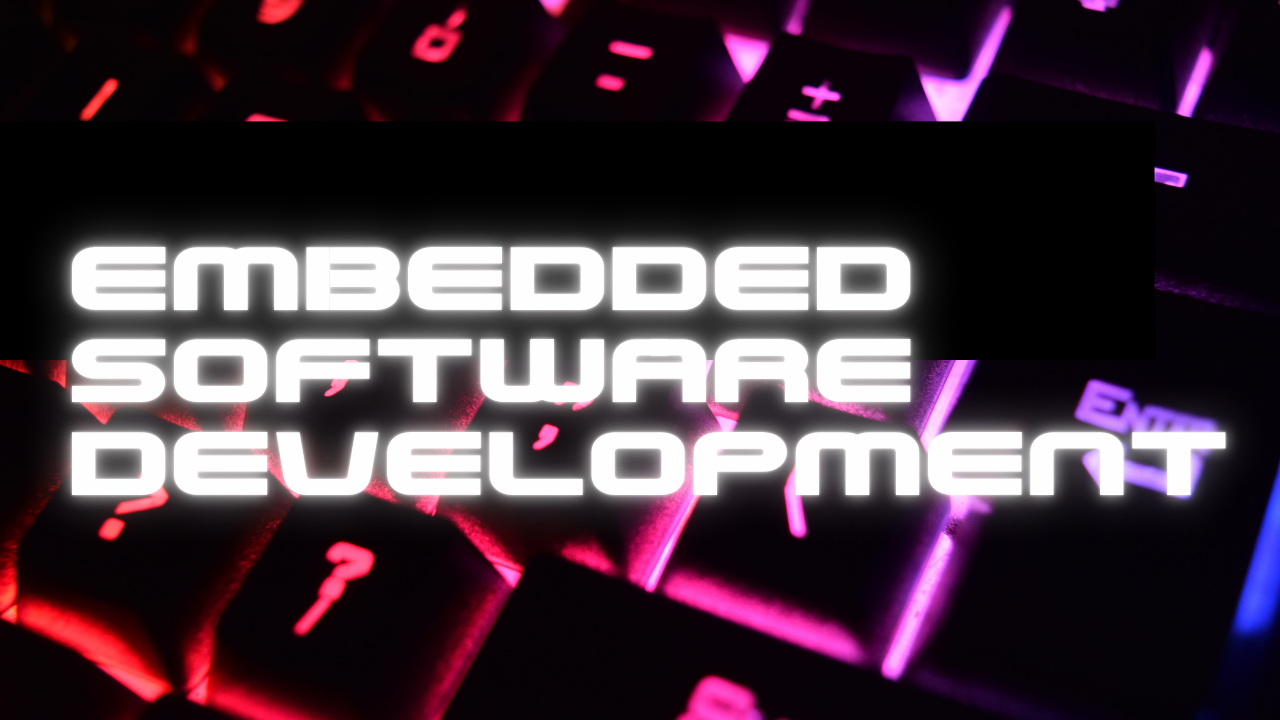Introduction
Imagine all the embedded circuitry in a microwave, a smart thermostat, or even a vehicle’s braking system — all run by embedded systems. Embedded software development is what they do to create and program the “brains” of these devices to make them work correctly. Since the products that we use daily are becoming “smarter” and “connected” via the Internet of Things (IoT), the need for embedded programmers is increasing rapidly.
From implementing embedded systems to tools, languages, and best practices for writing software for embedded systems, this primer will give you an overview of how to write embedded software. By the end of this article, you should now know how to start in this new industry.
Embedded Software Development: What is it?
Embedded software is software that is installed on hardware for a particular application. In contrast to computer-run general-purpose software, embedded software is used to manage very specialized devices that can be controlled with low-power microcontrollers or other devices. The program powers everything from household appliances to medical equipment, cars, and IoT devices. It serves the purpose of being in touch with the hardware to dictate the device’s behavior.
Embedded software development involves developing code that interfaces with and manages hardware. While typical software developers work with general-purpose hardware (general-purpose computers), embedded software authors have to consider hardware limitations like memory requirements, power consumption, and computational performance.
Know More About Embedded Systems Basics
Embedded systems consist of hardware and software that executes one another for some purpose. Here’s how their major components are organized:
Microcontrollers or Microprocessors are the “system’s brains”.” A microcontroller is a small integrated circuit (IC) that incorporates a CPU, memory, and I/O interfaces. It’s responsible for data processing and command execution.
Sensors and Actuators: Sensors pick up information about the environment, such as temperature, light, or motion, and relay that information to the microcontroller. Actuators are elements that transform electrical signals into physical effects – like motors, lights, or buzzers.
Modules for Communications: These enable the system to communicate with other devices. This could be a wired protocol (UART, SPI, I2C) or a wireless protocol (Wi-Fi, Bluetooth).
Power Supply: The microcontroller and all the peripherals rely on a stable power supply to function.
Most embedded systems also employ a Real-Time Operating System (RTOS). In contrast to a general-purpose operating system, an RTOS is meant to operate within a narrow timeline. It makes the system function predictable and timely, a huge plus for medical devices or car controls.
The Embedded Software Development Lifecycle.
Software that runs on an embedded platform is usually not as easy to program as any other software because it has tight interfaces with hardware and limited resources. It’s like this, to give you a short description:
Requirements Gathering: Determine the hardware and application’s needs and limitations. This involves selecting which microcontroller to use, which sensors/ peripherals to attach, and any functional constraints (e.g., low power, real-time feedback).
Planning and Design: After defining the needs, sketch the system design. Design choices include language, code structure, and module interplay.
Development and Implementation: Define the code to implement the embedded system. Embedded software generally comes in low-level languages, as the code should be efficient and close to the hardware.
Debugging and testing: Testing is especially important in embedded architectures, where failure can directly affect hardware behavior. Debugging Tools detect and troubleshoot problems, and tests are carried out on simulations and real hardware.
Installation: Once the software is ready and tested, it’s pushed to the microcontroller, and the entire embedded system goes into its final product.
Programming Languages for Embedded Development
- C & C++
Most embedded programming languages use C due to its low-level hardware access, efficiency, and portability to a wide range of microcontrollers. C++, too, is very popular in complex programming systems such as object-oriented programming.
- Assembly Language
Assembly language can be used to produce very performant application components. This low-level language provides direct access to the hardware, enabling developers to optimize performance and memory consumption down to the individual byte.
- Python and JavaScript
While uncommon, there are embedded devices (usually higher-powered systems like the Raspberry Pi or ESP32 boards) that can be programmed using Python or JavaScript to run scripts and prototype quickly. Python is a widely adopted language in IoT applications because it is easy to use and provides support for many libraries.
Most Useful Tools and Environments for Embedded Development
It is extremely important to choose appropriate tools for successful embedded programming. Here are some common tools:
- IDEs (Integrated Development Environments)
You write, compile, and debug your code with IDEs. These embedded development IDEs are some examples:
Keil: A popular ARM IDE.
Eclipse: An open-source IDE with embedded plugins available.
PlatformIO: A very versatile and cutting-edge IDE for many microcontrollers and boards.
Atmel Studio: An IDE for Atmel microcontrollers (since acquired by Microchip).
- Compilers and Debuggers — A Compiler / Debugger
Compilers translate your code into machine instructions that the microcontroller understands, and debuggers help you identify and correct bugs in your code. Common compilers and debuggers:
GCC (GNU Compiler Collection): A common cross-compiler for many microcontrollers.
GDB (GNU Debugger): A powerful debugger for debugging embedded programs.
- Emulators and Simulators
If physical hardware is unavailable, emulators and simulators can be used to test code. QEMU is a popular emulator that emulates many different hardware architectures, so you can test without the hardware.
Understanding Communication Protocols in Embedded Systems
Embedded systems typically require components to reach out to one another using various communication protocols:
- UART (Universal Asynchronous Receiver-Transmitter)
A basic serial communication protocol that allows two devices to exchange data.
- SPI (Serial Peripheral Interface)
High-speed, full-duplex protocol that communicates between microcontrollers and peripheral devices such as sensors and displays.
- I2C (Inter-Integrated Circuit)
An API that allows more than one device to talk to each other over a common data bus. It is slower than SPI but uses fewer lines, which is good for large systems.
- Networking (Wi-Fi, Bluetooth, MQTT)
Wireless protocols are a must for the IoT. We communicate locally and on the internet with Bluetooth and Wi-Fi, while message-sharing protocols such as MQTT are utilized in IoT networks.
Debugging and Testing Embedded Systems
Debugging embedded systems is challenging due to memory, time, and hardware restrictions. The following are some of the commonly used tools and techniques:
- Hardware Diagnostics Tools
Developers can directly debug using JTAG (Joint Test Action Group) and SWD (Serial Wire Debug).
Logic Analyzers: digital signals from embedded systems are read out and shown for timing problems diagnosis.
- Testing Methods of Software Systems
Unit Tests: Test for tiny, independent pieces of code.
Software-In-the-Loop (HIL): Evaluation of software by mimicking or running the hardware inside an environment.
Actual Hardware Environment Testing: Testing software in the actual hardware of its target environment in case there are edge cases or unexpected failures.
The Storage Management of Embedded Devices
Memory allocation is a priority in embedded systems due to the small hardware available. Correct memory management keeps the system consistent and efficient.
- Stack vs Heap Memory
Stack Memory: Provides static memory management, where the size and duration of variables are predetermined.
Heap Memory: Dynamic allocation of memory but with tight control to not let your memory bleed or fragment.
- Using Maximum Memory Efficiency
Fixed Memory Allocation: allocates memory in the compile time so there is no runtime overhead and fragmentation.
Memory Leaks Avoidance: Clearing dynamically allocated memory correctly to avoid memory exhaustion during a lifetime.
Real-Time Systems and What They Do
Most embedded systems are real-time systems, meaning they must react to an event or input at a specific moment.
Soft Real-Time Systems: Systems where deadlines aren’t too significant (video streaming).
Hard Real-Time: Systems where late deliveries can result in severe harm (car braking systems, medical devices).
This real-time constraint knowledge is vital for embedded programmers because it shapes how the system is built and how code is written.
Step-By-Step Guide to Embedded Development Getting Started with Embedded Development.
Here’s a short primer for those who would like to start with embedded software development:
- Configuring Your Development Environment
Select a Microcontroller: Pick a beginner microcontroller (such as Arduino or STM32) based on the project.
Choose an IDE and Tools: Download and install an IDE compatible with your microcontroller (Arduino IDE, PlatformIO).
- Building Your First Project
Program an Easy Program: You can start with a “Hello World” project, such as flashing an LED on your microcontroller board.
Flashing the Code: Build your code and send (or “flash”) it to your microcontroller.
- Compiling and debugging the code
Functionality Testing: You must test your code to see if everything works as expected.
Debugging Any Problems: Debugging issues with debugger tools to ensure code interfaces are properly connected to hardware.
Tip-Alternatives For Novices
Following are some links to get you started with embedded software development:
Online Courses: Websites such as Udemy, Coursera, and Pluralsight provide introductory-level courses in embedded systems.
Books: Books like “The Art of Electronics” by Paul Horowitz and “Programming Embedded Systems in C and C++” by Michael Barr offer detailed information.
Groups: Forums like Stack Overflow or EmbeddedRelated are a good place to share your concerns and hear other developers’ experiences.
Open-Source Development: Find and support open-source embedded software development projects on GitHub to get an in-the-flesh feel.
Development Jobs in Embedded Software Development
You can have multiple career prospects across various disciplines by programming embedded software. Here are some typical jobs:
Embedded Software Engineer: Build, develop, and test embedded software for many applications.
Firmware Programmer: You’re creating low-level hardware code.
IoT Developer: Smart devices that interact with each other and use wireless communications.
There is a great need for embedded software developers in industries such as automotive, medical, consumer electronics, and aerospace. Learning real-time systems, low-level programming, and hardware design skills can greatly improve your career prospects in this field.
Conclusion
Embedded software development is a special and lucrative profession in which hardware and software are integrated. From introducing embedded systems to understanding the major programming languages and tools used for development, you have seen all a novice would need to get started.
Embedded Systems is a big and fast-growing world that offers endless practice, challenges, and imagination in the engineering space. More and more, you’ll realize that embedded development doesn’t need only a technical skill set but also curiosity and patience. With patience, repetition, and education, you can master the programming language behind every gadget we take with us daily.
References
To know more check out:
What You Need to Know About Embedded Software Development
Check out our website for courses that can help you grow:

